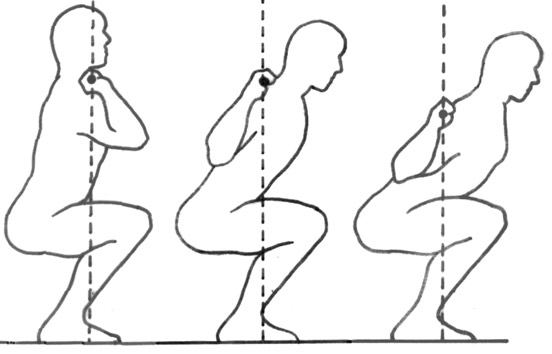I’ve always believed in the back squat for building muscle. But the front squat is an excellent exercise trainees should consider as well. Here’s an instructional video (more information below):
Here’s some research I found comparing the front squat to the standard (back) squat. It seems their may be some advantages to this exercise as far as long-term joint health goes:
The strength and stability of the knee plays an integral role in athletics and activities of daily living. A better understanding of knee joint biomechanics while performing variations of the squat would be useful in rehabilitation and exercise prescription. We quantified and compared tibiofemoral joint kinetics as well as muscle activity while executing front and back squats. Because of the inherent change in the position of the center of mass of the bar between the front and back squat lifts, we hypothesized that the back squat would result in increased loads on the knee joint and that the front squat would result in increased knee extensor and decreased back extensor muscle activity. A crossover study design was used. To assess the net force and torque placed on the knee and muscle activation levels, a combination of video and force data, as well as surface electromyographic data, were collected from 15 healthy trained individuals. The back squat resulted in significantly higher compressive forces and knee extensor moments than the front squat. Shear forces at the knee were small in magnitude, posteriorly directed, and did not vary between the squat variations. Although bar position did not influence muscle activity, muscle activation during the ascending phase was significantly greater than during the descending phase. The front squat was as effective as the back squat in terms of overall muscle recruitment, with significantly less compressive forces and extensor moments. The results suggest that front squats may be advantageous compared with back squats for individuals with knee problems such as meniscus tears, and for long-term joint health.1
This exercise also may reduce shearing force on the spine since you won’t be leaning forward as much (see the diagram):
I find the front squat hits the quadriceps more directly than the traditional back squat. It also seems to hit my abdominal muscles harder than back squats do.
One common problem is wrist strain, especially if you are trying to do the standard grip (palms facing up). You can work on wrist/forearm flexibility (through stretching), but another simple solution is to use lifting straps. I tried this and it works well check out this video (below) to see how it is done.
One final tip: I would recommend you stay in the lower rep range (5-6) for this exercise. The reason is the stabilizer muscles tend to tire out before your legs do.
You may want to give this exercise a try to ad some variety to your leg training.
Reference:
1. J Strength Cond Res. 2009 Jan;23(1):284-92. A biomechanical comparison of back and front squats in healthy trained individuals.